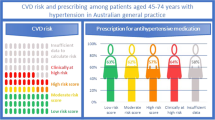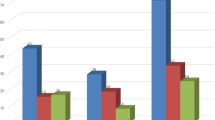Abstract
The CONTROLRISK study was designed to determine the cardiovascular risk profile of the hypertensive population attended at primary care and specialist setting in Spain and to investigate whether physicians stratify the risk correctly, according to the 2003 European guidelines. A total of 8920 patients were recruited from primary care (n=4485) and specialist outpatient clinic (n=4435). The age criteria was 62.6±11.1 years; 51.6% were women. No differences were observed in the severity of hypertension. More than 85% presented other cardiovascular risk factors, similarly in both groups. Target organ damage (TOD) and associated clinical conditions (ACC) were more frequent in specialist setting (57.6 vs 34.3% and 39 vs 28.7%, both P<0.0001). The most common risk factor was age. The most frequently reported TOD was left ventricular hypertrophy (42.3 and 22.1%; P<0.0001). Ischemic heart disease was the most common ACC (21.5 vs 13.1%; P<0.0001). The risk profile was significantly higher in specialist population (75.1 vs 60.3% of patients belonged to high- or very high-risk groups). Specialists and primary care physicians stratified only 54.6 and 48% of their patients correctly, respectively (P<0.05). Both, specialists and general practitioners (GPs) strongly underestimated the risk. Very high-risk patients were adequately assessed only in 44.9% of cases by specialists and in 25.3% by GPs (P<0.001). More than half of the hypertensive patients attended by GPs in Spain belong to the high- or very high-risk groups. GPs and specialists tend to underestimate the cardiovascular risk in daily clinical practice, mainly in very high-risk patients.
This is a preview of subscription content, access via your institution
Access options
Subscribe to this journal
Receive 12 digital issues and online access to articles
$119.00 per year
only $9.92 per issue
Buy this article
- Purchase on Springer Link
- Instant access to full article PDF
Prices may be subject to local taxes which are calculated during checkout

Similar content being viewed by others
References
Primatesta P, Poulter NR . Hypertension management and control among English adults aged 65 years and older in 2000 and 2001. J Hypertens 2004; 22: 1093–1098.
Primatesta P, Poulter NR . Improvement in hypertension management in England: results from the Health Survey for England 2003. J Hypertens 2006; 24: 1187–1192.
Fagard RH, Van Den Enden M, Leeman M, Warling X . Survey on treatment of hypertension and implementation of World Health Organization/International Society of Hypertension risk stratification in primary care in Belgium. J Hypertens 2002; 20: 1297–1302.
Hajjar I, Kotchen TA . Trends in prevalence, awareness, treatment, and control of hypertension in the United States, 1988–2000. JAMA 2003; 290: 199–206.
Rodriguez GC, Artigao LM, Llisterri JL, Alonso FJ, Banegas JR, Lou S et al. Control of hypertension in elderly patients receiving primary care in Spain. Rev Esp Cardiol 2005; 58: 359–366.
Banegas JR, Rodriguez-Artalejo F, Ruilope LM, Graciani A, Luque M, De la Cruz-Troca JJ et al. Hypertension magnitude and management in the elderly population of Spain. J Hypertens 2002; 20: 2157–2164.
Roca B, Suarez C, Ceballos A, Varela JM, Nonell F, Montes J et al. Control of hypertension in patients at high risk of cardiovascular disease. QJM 2005; 98: 581–588.
Aranda P . Arterial hypertension in Spain: the experience of the Spanish League. J Hum Hypertens 1996; 10 (Suppl 1): S73–S75.
Puras A, Sanchis C, Artigao LM, Divison JA . Prevalence, awareness, treatment, and control of hipertension in a Spanish population. Eur J Epidemiol 1998; 14: 31–36.
Banegas JR, Segura J, Ruilope LM, Luque M, Garcia-Robles R, Campo C et al. Blood pressure control and physician management of hypertension in hospital hypertension units in Spain. Hypertension 2004; 43: 1338–1344.
The Joint National Committee on Prevention, Detection, Evaluation, and Treatment of High Blood Pressure and the National High Blood Pressure Education Program Coordinating Committee. The Sixth Report of the Joint National Committee on Prevention, Detection, Evaluation, and Treatment of High Blood Pressure. Arch Intern Med 1997; 157: 2413–2446.
Whitworth JA, 2003 World Health Organization (WHO)/International Society of Hypertension Writing Group. 2003 World Health Organization (WHO)/International Society of Hypertension (ISH) statement on management of hypertension. J Hypertens 2003; 21: 1983–1992.
2003 European Society of Hypertension. European Society of Cardiology guidelines for the management of arterial hypertension. J Hypertens 2003; 21: 1011–1053.
Gonzalez JR, Alegria E, Aznar J, Bertomeu V, Franch J, Palma JL . Knowledge and implementation of cardiovascular risk clinical practice guidelines by general practitioners and specialists. Rev Esp Cardiol 2006; 59: 801–806.
Spranger CB, Ries AJ, Berge CA, Radford NB, Victor RG . Identifying gaps between guidelines and clinical practice in the evaluation and treatment of patients with hypertension. Am J Med 2004; 117: 14–18.
Backlund L, Bring J, Strender L-E . How accurately do general practitioners and students estimate coronary risk in hypercholesterolaemic patients. Primary Health Care Res Dev 2004; 5: 145–152.
Persson M, Carlberg B, Mjörndal T, Asplund K, Bohlin J, Lindholm L . 1999 WHO/ISH guidelines applied to a 1999 MONICA sample from northern Sweden. J Hypertens 2002; 20: 29–35.
Bhatt DL, Steg PG, Ohman EM, Hirsch AT, Ikeda Y, Mas JL . International prevalence, recognition, and treatment of cardiovascular risk factors in outpatients with atherothrombosis. JAMA 2006; 295: 180–189.
Rutten FH, Grobbee DE, Hoes AW . Differences between general practitioners and cardiologists in diagnosis and management of heart failure: a survey in every-day practice. Eur J Heart Fail 2003; 5: 337–344.
Peters TJ, Montgomery AA, Fahey T . How accurately do primary health care professionals use cardiovascular risk tables in the management of hypertension? Br J Gen Pract 1999; 49: 987–988.
Montgomery AA, Fahey T, Mackintosh C, Sharp DJ, Peters TJ . Estimation of cardiovascular risk in hypertensive patients in primary care. Br J Gen Pract 2000; 50: 127–128.
McManus RJ, Mant J, Meulendijks CFM, Salter RA, Pattison HM, Roalfe AK et al. Comparison of estimates calculations risk of coronary heart disease by doctors and nurses using different calculation tools in general practice: cross sectional study. BMJ 2002; 324: 459–464.
Sheridan S, Pignone M, Mulrow C . Framingham-based tools to calculate the global risk of coronary heart disease: a systematic review of tools for clinicians. J Gen Intern Med 2003; 18: 1060–1061.
Williams B, Poulter NR, Brown MJ, Davis M, McInnes GT, Potter JF et al. British Hypertension Society guidelines for hypertension management 2004 (BHS-IV): summary. BMJ 2004; 328: 634–640.
Simpson FO . Guidelines for antihypertensive therapy: problems with a strategy based on absolute cardiovascular risk. J Hypertens 1996; 14: 683–689.
Camisasca P, Avanzini F, Alli C, Colombo F, Tognoni G . Overall cardiovascular risk still ignored in general practice care of hypertension. J Cardiovasc Risk 2002; 9: 147–152.
Gonzalez JR, Alegria E, Lozano JV, Caro JL, Acuna JG, Maqueda IG . Impact of hypertension in cardiac diseases in Spain. The CARDIOTENS Study 1999. Rev Esp Cardiol 2001; 54: 139–149.
Cabana M, Rand C, Powe N, Wu A, Wilson M, Abbound PA et al. Why don't physicians follow clinical practice guidelines? JAMA 1999; 282: 1458–1465.
Echlin PS, Upshur RE, Markova TP . Lack of chart reminder effectiveness on family medicine resident JNC-VI and NCEP III guideline knowledge and attitudes. BMC Fam Pract 2004; 5: 14.
Brand C, Landgren F, Hutchinson A, Jones C, Macgregor L, Campbell D . Clinical practice guidelines: barriers to durability after effective early implementation. Intern Med J 2005; 35: 162–169.
Hutchinson BG, Abelson J, Woodward CA, Norman G . Preventive care and barriers to effective prevention: how do family physicians see it. Can Fam Physician 1996; 42: 1693–1700.
Cuspidi C, Meani S, Salerno M, Severgnini B, Fusi V, Valerio C et al. Cardiovascular risk stratification according to the 2003 ESH/ESC guidelines in uncomplicated patients with essential hypertension: comparison with the 1999 WHO/ISH guidelines criteria. Blood Press 2004; 13: 144–151.
Luque M, de Rivas B, Alvarez B, Garcia G, Fernandez C, Martell N . Influence of target organ lesion detection (assessment of microalbuminuria and echocardiogram) in cardiovascular risk stratification and treatment of untreated hypertensive patients. J Hum Hypertens 2006; 20: 187–192.
Sever P, Dahlöf B, Poulter N, Wedel H, Beevers G, Caulfield M et al. For the ASCOT INVESTIGATORS prevention of coronary and stroke events with atorvastatin in hypertensive patients who have average or lower-than-average cholesterol concentrations, in the Anglo-Scandinavian Cardiac Outcomes Trial–Lipid Lowering Arm (ASCOT–LLA): a multicentre randomised controlled trial. Lancet 2003; 361: 1149–1158.
Acknowledgements
The present study was supported by an unrestricted grant provided by the HOR Unit of Novartis Pharmaceuticals.
Author information
Authors and Affiliations
Consortia
Corresponding author
Rights and permissions
About this article
Cite this article
Barrios, V., Escobar, C., Calderón, A. et al. Cardiovascular risk profile and risk stratification of the hypertensive population attended by general practitioners and specialists in Spain. The CONTROLRISK study. J Hum Hypertens 21, 479–485 (2007). https://doi.org/10.1038/sj.jhh.1002167
Received:
Revised:
Accepted:
Published:
Issue Date:
DOI: https://doi.org/10.1038/sj.jhh.1002167
Keywords
This article is cited by
-
Predicted cardiovascular disease risk and prescribing of antihypertensive therapy among patients with hypertension in Australia using MedicineInsight
Journal of Human Hypertension (2022)
-
Evaluation of the quality of care of a multi-disciplinary Risk Factor Assessment and Management Programme for Hypertension (RAMP-HT)
BMC Family Practice (2015)
-
Impact of global risk assessment on the evaluation of hypertensive patients treated by primary care physicians in Korea
Hypertension Research (2014)
-
Cardiovascular protection for all individuals at high risk: evidence-based best practice
Clinical Research in Cardiology (2008)



